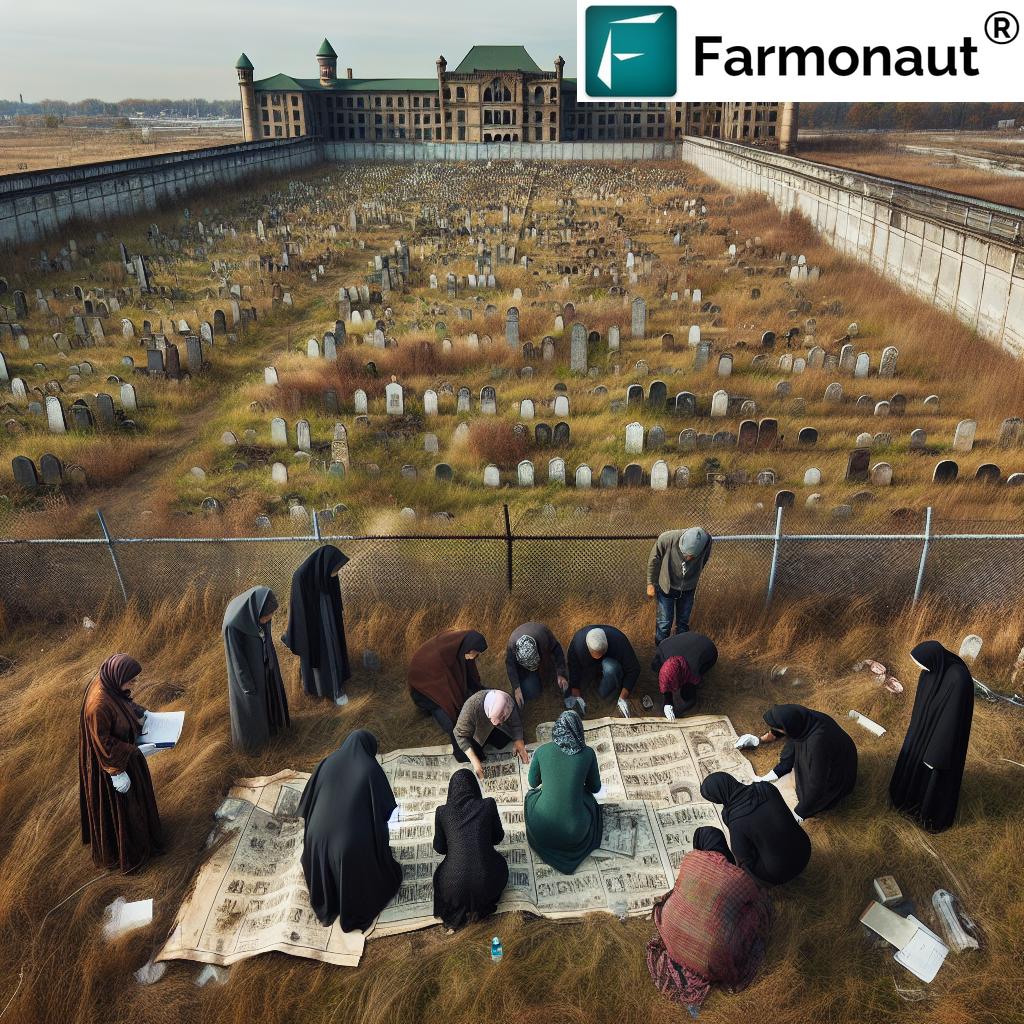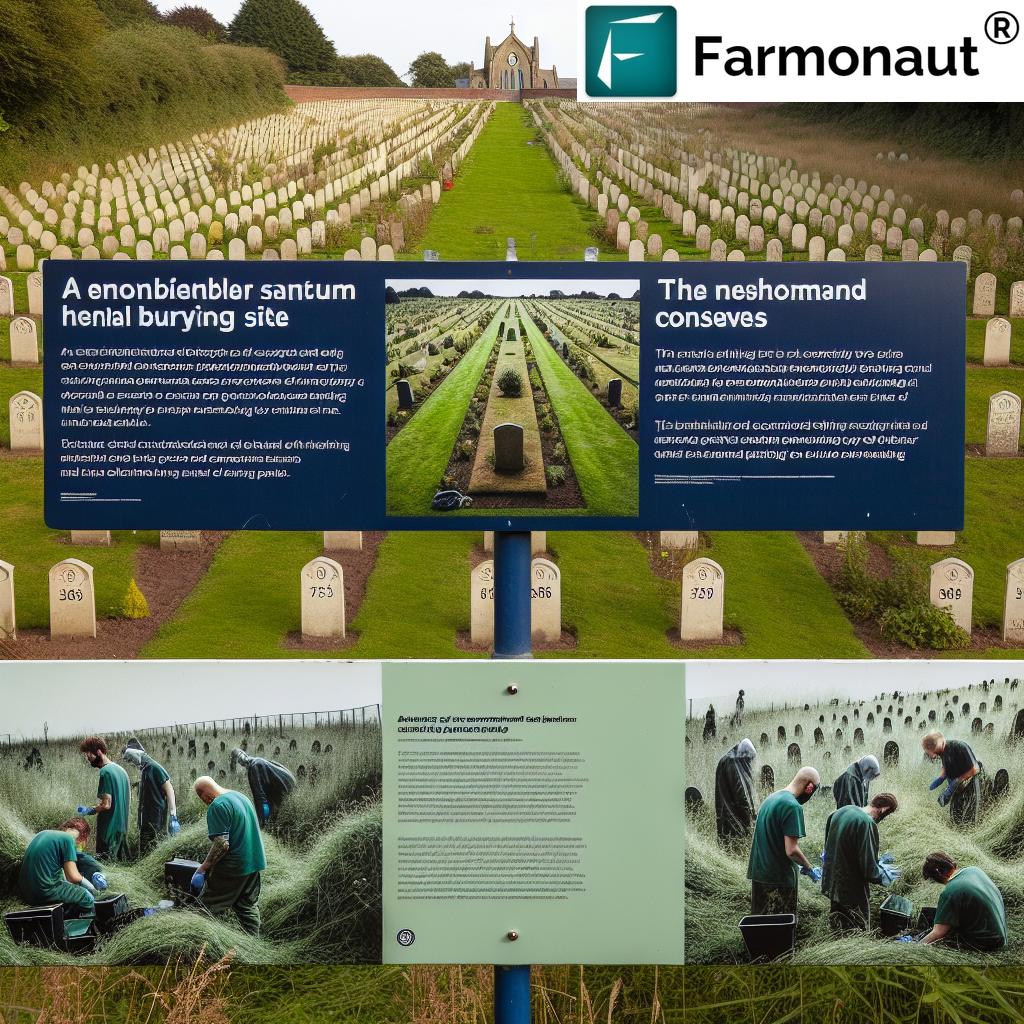Uncovering Detroit’s Forgotten: Eloise Cemetery Restoration Efforts Reveal Hidden Histories
“Over 7,000 forgotten patients are estimated to be buried in Eloise Cemetery, a neglected historic potter’s field in Michigan.”
In the heart of Westland, Michigan, lies a somber reminder of our society’s often-forgotten past. Eloise Cemetery, a neglected historic potter’s field, stands as a silent testament to the lives of thousands who were once residents of the Eloise medical complex. This facility, which operated from 1839 to 1982, encompassed a poorhouse, sanitarium, and asylum. Today, we embark on a journey to uncover the hidden histories of those interred in this sacred ground and explore the ongoing efforts to restore dignity to the deceased.
The Haunting History of Eloise Cemetery
Eloise Cemetery serves as the final resting place for approximately 7,100 individuals, many of whom were patients at the Eloise medical complex. As we delve into the history of this neglected cemetery, we’re confronted with a stark reality: the site lacks any signage or pathways, with headstones mostly buried and only numbers marking the graves. This barren landscape symbolizes the disregard faced by the poor and mentally ill, both during their lifetimes and in death.
The last burial at Eloise Cemetery occurred in 1948, after which bodies were sent to Wayne State University School of Medicine. Throughout the years, the cemetery has been poorly maintained, overgrown with grass, and neglected by Wayne County, which once owned the land. This neglect has led to a complex web of challenges for those seeking to uncover the stories of their ancestors and restore the dignity of the departed.

The Challenge of Lost Records and Hidden Graves
One of the most significant obstacles in the restoration efforts of Eloise Cemetery is the loss of burial records. Most records identifying the deceased have been lost, leaving descendants like Stacey Hoppe and Chris Wilmoth frustrated in their search for familial connections. The cemetery’s records were formerly maintained in ledgers that have since gone missing, contributing to the complex intertwinement of personal stories and the overarching tragedy of institutional neglect.
Genealogists and the Westland Historical Commission field inquiries from interested parties weekly, but many are met with obstacles due to the missing records and the cemetery’s deteriorated state. This situation highlights the critical importance of proper record-keeping and preservation in maintaining historical sites and honoring the memory of the deceased.
Uncovering Hidden Headstones: A Labor of Love
“Eloise Cemetery restoration efforts have uncovered hundreds of hidden headstones, revealing lost histories of asylum patients.”
Despite the challenges, dedicated volunteers have taken up the mantle of restoring Eloise Cemetery and uncovering its hidden histories. Local volunteers like Felicia Sills have actively sought to restore dignity to the deceased by discovering and cleaning hidden headstones. These efforts involve painstaking work, often requiring careful excavation and gentle cleaning to reveal the identities of those long forgotten.
The process of uncovering hidden headstones is not just about physical restoration; it’s a journey of rediscovery and remembrance. Each uncovered gravestone represents a life once lived, a story waiting to be told. As we unearth these markers, we’re piecing together a mosaic of Detroit’s history, one that includes the often-overlooked stories of its most vulnerable citizens.
The Intersection of History and Modern Development
The story of Eloise Cemetery is not just one of historical neglect; it’s also a tale of urban development and its impact on historical sites. The surrounding area has seen significant changes over the years, with the development of condominiums, strip malls, and golf courses. This encroachment of modern life on historical grounds further emphasizes the need for dedicated preservation efforts.
It wasn’t until potential development in the area that the county acknowledged the cemetery’s existence. This revelation serves as a stark reminder of how easily important historical sites can be overlooked or forgotten in the face of progress. As we continue to grow and develop our cities, it’s crucial that we maintain a balance between progress and preservation, ensuring that the stories of our past are not erased by the march of time.
The Ethical Dilemma: Haunted Attractions and Historical Tragedy
In recent years, interest in Eloise Cemetery has grown alongside the nearby Eloise Asylum, a haunted attraction that has capitalized on the complex’s dark history. This development raises important ethical questions about the intersection of entertainment and historical tragedy. While such attractions can bring attention to forgotten histories, they also risk trivializing the very real suffering of those who lived and died at institutions like Eloise.
As we consider the future of Eloise Cemetery and similar sites, we must grapple with these complex issues. How do we balance the need for historical preservation and education with the desire for entertainment? How can we ensure that the stories of those interred at Eloise are told with respect and dignity, rather than sensationalized for profit?

The Role of Technology in Cemetery Preservation
In our efforts to uncover and preserve the hidden histories of Eloise Cemetery, technology plays an increasingly important role. While not directly related to cemetery preservation, innovative technologies like those developed by Farmonaut demonstrate the potential for technological solutions in various fields, including historical preservation.
Farmonaut’s satellite-based monitoring systems, originally designed for agricultural purposes, could potentially be adapted for use in cemetery preservation efforts. By utilizing advanced imaging techniques, preservationists could map out burial sites, identify areas of interest for further investigation, and monitor changes in the landscape over time.
To learn more about Farmonaut’s innovative technologies, visit their web app or explore their offerings on Android and iOS.
The Importance of Community Involvement
The restoration of Eloise Cemetery is not just a task for historians and preservationists; it’s a community effort that requires the involvement of local residents, descendants of those buried there, and concerned citizens. Community involvement is crucial in ensuring that the restoration efforts are sustained over time and that the stories uncovered are shared with future generations.
Local initiatives, such as volunteer clean-up days and educational programs, can help raise awareness about the cemetery’s importance and encourage more people to get involved in its preservation. By fostering a sense of community ownership over this historical site, we can ensure that the memories of those buried at Eloise are not lost to time.
Genealogy Research Challenges and Breakthroughs
For many descendants of those buried at Eloise Cemetery, the search for family connections is fraught with challenges. The loss of burial records and the deteriorated state of the cemetery make traditional genealogical research difficult. However, dedicated genealogists and researchers are finding innovative ways to piece together the stories of those interred at Eloise.
Some researchers have turned to state death records, cross-referencing them with what little information is available about the cemetery to identify potential burials. Others are using DNA testing and family history databases to connect with potential relatives and fill in the gaps in their family trees. These efforts not only help individuals uncover their personal histories but also contribute to the broader understanding of the lives of those who passed through Eloise.
The Future of Eloise Cemetery
As we look to the future of Eloise Cemetery, there are signs of hope. The new owner, John Hambrick, who operates the nearby haunted attraction, has expressed intentions to allow public access and is planning to place a commemorative plaque for the cemetery. While this is a step in the right direction, it’s clear that much work remains to be done to fully restore and honor this historic site.
The future of Eloise Cemetery will likely involve a combination of physical restoration, historical research, and community engagement. By working together, we can transform this neglected potter’s field into a place of remembrance and reflection, where the stories of those long forgotten can finally be told.
Timeline of Eloise Cemetery Restoration Efforts
| Year | Event | Significance |
|---|---|---|
| 1948 | Last burial at Eloise Cemetery | Marks the end of active use of the cemetery |
| 1982 | Closure of Eloise medical complex | Contributes to the neglect of the cemetery |
| 2000s | Increased public interest in Eloise history | Sparks initial efforts to research and preserve the cemetery |
| 2015 | Formation of volunteer groups | Begins organized efforts to clean and restore the cemetery |
| 2018 | Discovery of hidden headstones | Reveals the extent of the cemetery and its hidden histories |
| 2020 | New ownership of adjacent property | Brings potential for improved access and recognition |
| 2022 | Proposal for commemorative plaque | Marks a step towards official recognition and remembrance |
| Ongoing | Continued restoration and research efforts | Gradually uncovers and preserves the stories of those buried at Eloise |
The Broader Impact: Mental Health Awareness and Social Justice
The story of Eloise Cemetery is not just about preserving a historical site; it’s also a powerful reminder of the importance of mental health awareness and social justice. The treatment of patients at institutions like Eloise reflects the societal attitudes of the past towards mental illness and poverty. By uncovering and sharing these stories, we can contribute to ongoing discussions about mental health care, social welfare, and the treatment of society’s most vulnerable members.
As we work to restore Eloise Cemetery, we’re also working to restore dignity to those who were often marginalized or forgotten in life. This process of remembrance and recognition can help inform current debates about mental health policy, institutional care, and the rights of the economically disadvantaged.
The Power of Remembrance
As we conclude our exploration of Eloise Cemetery and the efforts to uncover its hidden histories, we’re reminded of the power of remembrance. Each life interred in this historic potter’s field had value, each story deserves to be told. By dedicating ourselves to the preservation and restoration of sites like Eloise Cemetery, we honor not just those buried there, but also the fundamental dignity of all human life.
The journey to fully restore Eloise Cemetery and uncover all its secrets is far from over. It will require continued dedication, community support, and innovative approaches to historical preservation. But with each headstone uncovered, each record pieced together, we move closer to ensuring that those once forgotten are remembered once more.
As we move forward, let us carry with us the lessons learned from Eloise Cemetery. Let us remember the importance of preserving our history, even – and especially – when that history is difficult or painful. And let us continue to work towards a society that values and cares for all its members, both in life and in death.
FAQ Section
- Q: How many people are buried in Eloise Cemetery?
A: Approximately 7,100 individuals are estimated to be buried in Eloise Cemetery. - Q: When was the last burial at Eloise Cemetery?
A: The last burial at Eloise Cemetery occurred in 1948. - Q: Why are there no traditional headstones at Eloise Cemetery?
A: The cemetery used concrete blocks instead of traditional headstones to limit costs, reflecting the economic status of those buried there. - Q: What happened to the burial records for Eloise Cemetery?
A: Most of the burial records have been lost over time, making it difficult to identify many of those interred at the site. - Q: How can I get involved in the restoration efforts for Eloise Cemetery?
A: You can contact the Westland Historical Commission or local volunteer groups to inquire about ongoing restoration efforts and opportunities to contribute.
Earn With Farmonaut: Affiliate Program
Earn 20% recurring commission with Farmonaut’s affiliate program by sharing your promo code and helping farmers save 10%. Onboard 10 Elite farmers monthly to earn a minimum of $148,000 annually—start now and grow your income!
Farmonaut Subscriptions
As we conclude this exploration of Eloise Cemetery and its ongoing restoration efforts, we’re reminded of the importance of preserving our history and honoring those who came before us. While the challenges are significant, the dedicated work of volunteers, researchers, and community members offers hope for the future of this sacred ground. By continuing to uncover and share these hidden histories, we ensure that the lives of those buried at Eloise are not forgotten, but remembered and honored for generations to come.
For those interested in learning more about innovative technologies that could potentially aid in historical preservation efforts, consider exploring Farmonaut’s API or their API Developer Docs. While primarily focused on agricultural applications, these tools demonstrate the potential for technology to assist in various fields of research and preservation.







